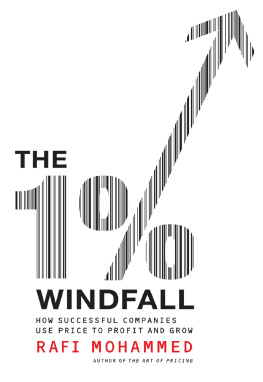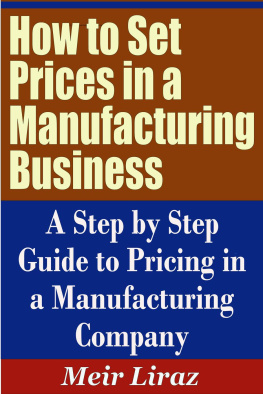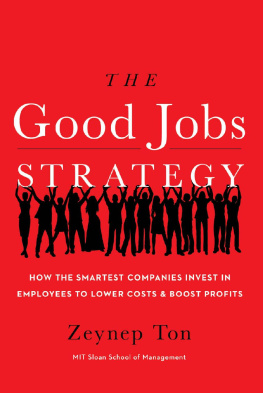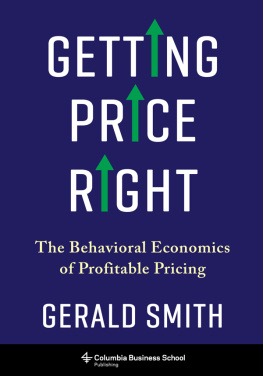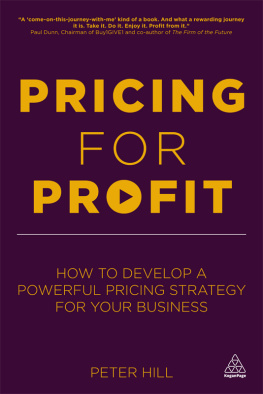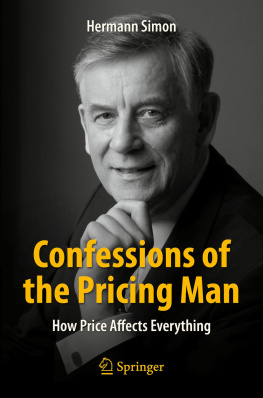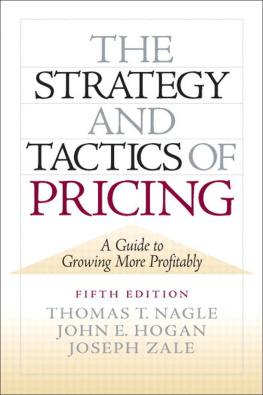The 1% Windfall
T here is a fundamental profit disconnect in business today. Companies work to bring a product to market by investing significant effort and money in research and development, distribution, and marketing strategies. But when it comes to setting a pricehow businesses get compensated for their hard work and financial riskmost companies drop the ball. Critical pricing decisions are often made using arbitrary this is the way weve always done it methods. Companies are shortchanging themselves every day.
Most managers arent comfortable setting prices. With few pricing golden rules and little practical guidance for improvement, its understandable why firms have continued with the status quo. How are companies setting prices today? Most react. Instead of a driver of new profits, prices are a mix of marking up costs, maintaining margins, matching competitors, and seat-of-the-pants analyses.
Since pricing is an underutilized strategy, it is fertile ground for new profits. Focusing on better pricing is a quick path to new profits and growth. Most business improvement initiatives require significant capital investment and long seed-to-harvest periods to determine whether or not the effort pays off. In contrast, many of the concepts that I will discuss are straightforward to implement and can start producing profits almost immediately. Consider Costcos signature $1.50 quarter-pound hot dog and soda special. A small increase to $1.52 (and carrying this percentage increase across all of Costcos prices) would boost this warehouse clubs operating profits by 48%.1 And heres the best part: prices can be changed on Sunday night and new profits will start flowing in on Monday morning. Ive seen it.
Most companies dont realize the direct link between prices and their profits. Its this connection that makes pricing one of the most powerful strategies available to businesses today. A manufacturing company I work with has operating profits of 5%it banks 5 cents of every dollar of revenue it collects. If this company raised prices by just 1% (charged, say, $1.01 instead of $1.00), it would earn an extra penny per revenue dollar (its profits would be 6 cents instead of 5 cents). This extra penny translates into a 20% increase in operating profits (1 extra cent per 5 current cents of profit). This calculation, of course, assumes that demand for the product remains constant at the elevated price. The point is that a small change in price can have a big effect on a companys financial bottom line.
A study by McKinsey & Company of the Global 1200 found that if they increased their prices by just 1%, and demand remained constant, on average each companys operating profits would increase by 11%.2 Based on my analysis of revenue and operating income data from 2008 annual financial statements, Figure I-1 reveals how a 1% price increase would boost the operating incomes of several well-known companies.
Figure I-1 1% Windfall for Select Fortune 500 Companies
THE EFFECTS OF A 1% PRICE INCREASE
Company: Sears
1% Windfall Operating Profit Increase: 155%
Company: McKesson
1% Windfall Operating Profit Increase: 100%
Company: Tyson
1% Windfall Operating Profit Increase: 81%
Company: Land OLakes
1% Windfall Operating Profit Increase: 58%
Company: Whirlpool
1% Windfall Operating Profit Increase: 34%
Company: Humana
1% Windfall Operating Profit Increase: 27%
Company: Amazon
1% Windfall Operating Profit Increase: 23%
Company: Wal-Mart
1% Windfall Operating Profit Increase: 18%
Company: Home Depot
1% Windfall Operating Profit Increase: 16%
*Calculations based on 2008 annual data and assume that demand remains constant after 1% price increase.
The benefits of a 1% price increase are compounded when measured in terms of their effects on a companys market capitalization. The value of a companyhow much it is worthis often calculated as a multiple of its current earnings. The standard convention is to multiply a companys annual earnings by its price-to-earnings ratio (share price divided by net earnings per share) to determine its total value. In the case of Wal-Mart, given its price-to-earnings ratio of 14.56 and 2008 net income of $13.4 billion, an estimate of its market capitalization is $195 billion.3 Since a 1% price increase leads to a higher net income, this in turn boosts a companys market capitalization. A ballpark measure of the effect of a 1% price increase on Wal-Marts capitalization involves multiplying the additional net income derived from a 1% price increase ($2.6 billion) by its P/E ratio of 14.56. In this case, Wal-Marts 1% windfall is roughly an extra $37.9 billion in market capitalization.4
These are very powerful results. As I tell my clients, 1% is a small numberand achievable.
A PROFIT OPPORTUNITY FOR COMPANIES
Whether the size of a companys 1% windfall is high or low (as measured by operating profit margins, market capitalization, or additional profits), pricing is an important strategy for every business. It is a primary variable in determining profit, as well as a key attribute that consumers consider before making a purchase.
Its surprising how many people within an organization care about and touch prices: CEOs searching for fast profits, CFOs focusing on revenue (instead of cutting costs) to improve financial health, marketing managers setting prices, product managers counting on price to meet their P&L responsibilities, and sales managers seeking new ideas to help with their daily pricing negotiations. Clearly, pricing is an important strategy for many levels of a company.
Without a general philosophy on how to approach pricing issues, its inevitable that a range of conflicting pricing fiefdoms set up camp within a company. It is common to encounter various managers who want to keep my margins above a target percentage, mark up my costs by a fixed amount, or be the king of market share. Every company has a few who want to give my customers as many discounts as possible. Its rare to meet a manager focused on using a mix of pricing strategies to make the most profit.
The unavoidable result of these competing pricing philosophies is confusion and frustration. With no means to resolve these differences, its understandable why many employees end up with an Oh well attitude toward pricing. This lackadaisical resignation leads to missed profits and opportunities.
Because of their challenging experiences and the role that pricing plays in their jobs, Ive found that staff members are interested in discussing and learning more about pricing. After he read my first pricing book, The Art of Pricing , Larry Waxman, president of Waxman Industries, told me: I like to gather our management team together to discuss our business. Pricing is a good topic that brings my team togethereveryone is interested in it. And while I call it a pricing meeting, we always end up talking about other issues too. Pricing is a common denominator throughout a company.
No team can achieve the best results if its members cannot agree on the goals and actions necessary to reach them. Once, while I was moderating a pricing discussion among senior executives of a Fortune 500 company, one participant sat up straight in her chair and said, Now I finally feel that we are on the same page. And she was right. These executives had a history of bad pricing experiences, and there was an ongoing conflict over how to set prices. Money was being left on the table daily.
This book starts a crucial conversation about pricing that needs to take place within every organization. It creates common ground for better pricing. Most employees take pride in the products and services they provide and want their company to succeed financially. But to do better, they need pricing guidance.

